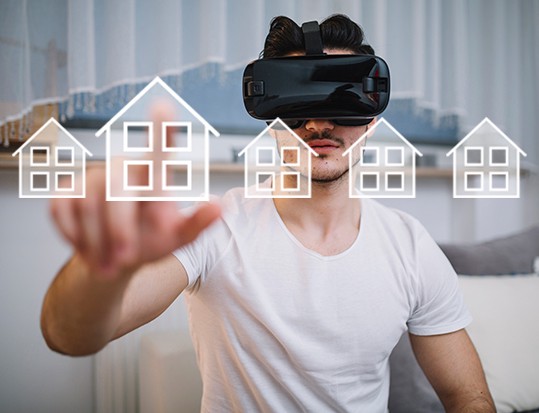2020 is the year where virtual events and meetings have dominated the cultural landscape. While traditional businesses are usually what first comes to mind in this virtual age, it is important to note the popularity of virtual tours in real estate.
In the midst of the pandemic, virtual tours have essentially become an invaluable tool to maintain some level of normalcy in real estate. Some would argue that these virtual tours are game-changers.
Let’s look at the pros and cons of virtual real estate tours from the vantage point of those planning on buying real estate.
Pros of Virtual Tours:
1. Potential buyers can view homes conveniently from their computers or mobile device.
Particularly in a pandemic, this is a huge selling point. Also, it helps because the potential buyer can repeat the virtual tour as often as necessary. This is useful if comparing the property with others also viewed virtually. Or if the buyer wants to share the virtual tour with a family member or loved one to get another opinion.
Being able to view homes from a computer or mobile device is even more valuable in areas with very warm or cold climates. Whether you are buying a home in Phoenix, Arizona in July or a home in Boston, Massachusetts in the middle of winter, virtual tours provide a comfortable alternative.
2. There is no limit to the number of virtual tours potential buyers can do.
In a traditional setting, the potential buyer would need to schedule an appointment with his or her real estate agent who would show multiple houses. Each house would require an allotted amount of time and driving time between the properties would also have to be factored in. There is no doubt virtual home tours are more time-efficient.
3. No in-person interaction is necessary for virtual tours.
The potential buyer doesn’t need a realtor or any other arrangement to tour properties. This is an advantage during a pandemic but can also be considered a disadvantage which will be discussed later.
Cons of Virtual Tours:
1. Lighting can be skewed.
Whether it is the 360-degree camera, the time of day of the tour, or the potential buyer’s computer or mobile device, the actual lighting versus the virtual lighting will not be the same. Why is this significant? Lighting can change how things appear in terms of size and proportion in the home. Even the color of the walls will look totally different in person.
2. The virtual tour does not encompass the neighborhood.
Virtual tours usually focus on the property itself and not the adjoining neighborhood. It is difficult to get a feel for the traffic flow in the streets surrounding the property. Perhaps there is a local airport nearby.
It is impossible to know without physically being at the property if there are noise or other issues related to aircraft taking off and landing nearby. The airport could be 5-10 miles away so the buyer may not even consider that to be a factor unless he or she is physically present on the property.
3. Virtual tours can be deceptive.
This is not meant in an underhanded way. Much like staging houses, virtual tours show the property at its best. Photographs and videos are shot at flattering angles and may give a distorted picture of the size of rooms, hallways, storage spaces, etc.
4. There is no substituting an in-person visit to a property.
Walking the neighborhood, examining the sidewalks and neighboring properties, understanding if it is a family-oriented neighborhood, and just gaining the homey feeling can only be achieved in person. Similarly, a leaky faucet or moldy smell in a basement cannot be revealed in a virtual tour. The virtual tour allows limited sight of the property. The other senses can only be used in person.
Also, when walking through a house, prospective buyers try to picture their furnishings and personal items in the home. Are there big pieces of furniture that may not fit through narrow doorways or cannot be easily maneuvered on windy staircases? Only walking through a house can tell a buyer those things.
Who Benefits Most From Virtual Tours in 2020?
Real estate agents benefit the most from virtual tours. It is a tool that engages potential buyers without worrying about COVID-19 restrictions. Conversations and relationships can begin between those buying real estate and realtors as a result of virtual tours.
Also, people who may want to buy a property but have no definite deadline or timetable can benefit from virtual tours. They can essentially shop around indefinitely.
On the other hand, people who may want to downsize or put their homes up for sale post-pandemic could benefit also. These people can take virtual tours of comparable houses within their neighborhood or surrounding neighborhoods to get an idea of the viability and value of a current property.
Who Would Benefit Least From Virtual Tours?
Those who need to buy and sell real estate quickly do not benefit as much from virtual tours. Families who need to relocate quickly due to a job change or transfer may not have time for virtual tours. Those individuals really need to get in the homes and buy real estate the old-fashioned way.
Final Thoughts
In the end, virtual tours are a great tool for those who really need them or love them, and when combined with traditional home-viewing, provide the most comprehensive home-buying experience.
Whereas online sales of clothing, furniture, and other household items have dominated, online sales of homes and real estate properties will never be the norm and would be considered by most people as being risky purchases.
Virtual tours are a huge step forward and a great marketing tool, but they should never be considered as a replacement for the in-person real estate transaction. If you like the article then follow TechRado for more!
